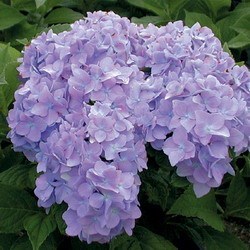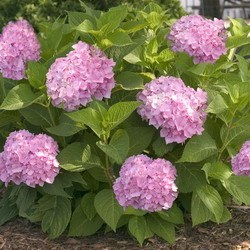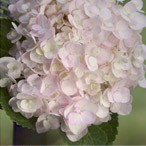Endless Summer big leaf hydrangea is about the best summer-blooming shrub you can ask for.
Colorful and easy to grow and care for, this is one flowering shrub that isn’t bothered by pests or diseases – and it blooms its head off for weeks at a time.
Flowering shrubs with long bloom times

Hydrangea ‘Endless Summer’ in blue
The reason the flowers – which are generally pink or blue – go on for so long has to do with the fact that the showy parts aren’t petals at all.
They are in fact colorful sepals that are sterile, but are showy to attract pollinating insects. The fertile florets, usually found in the center of the cluster, are quite small and inconspicuous.
They are in fact colorful sepals that are sterile, but are showy to attract pollinating insects. The fertile florets, usually found in the center of the cluster, are quite small and inconspicuous.
The flower heads of big-leaved mopheads and lacecaps consist mostly of showy sepals with a few small fertile flowers inside.
The sepals can’t be pollinated so they don’t go to seed, and that’s why the “flowers” last so long.
How to grow H. macrophylla:

Endless Summer Hydrangea in pink
These shrubs tend to bloom on the previous season’s growth, which means that the stems usually die back to the ground, so they will produce flowers only in Zone 6 and warmer.
Hardier cultivars:
Endless Summer and ‘Blushing Bride’
‘Bailmer’, sold under the trade name of Endless Summer, is hardy to Zone 4, which means that gardeners in more northerly areas can now enjoy H. macrophylla flowers too.
Endless Summer blooms in blue (above) or pink (right). In acid soil (pH 5.0), the flowers are blue; in neutral to alkaline soil they are pink. (Learn more about soil pH.)

‘Blushing Bride’
‘Blushing Bride’ (right) has pure white blooms with semi-double florets that gradually mature to a sweet, pink blush. Both cultivars start blooming in mid-summer and keep going because they set new buds and flowers throughout the season.
Aside from adding a 10-cm layer of winter mulch, these shrubs don’t need any special winter protection, even in Zone 4.
Both cultivars bloom on both old and new growth. You can encourage more flowers by deadheading and pruning back flowering stems to a pair of healthy buds. The only other care needed is to prune out winter-damaged stems in early spring.
Other cultivars: ‘Nikko Blue’ is another mophead type that for many years was one of the few relatively hardy big-leafed types available. ‘Pink Beauty’ is another form available to gardeners in Zone 6 and warmer.
However, even in Zone 6, many gardeners protect these cultivars by stuffing leaves around the shrub and covering it with an overturned bushel basket or burlap.
Growing tips: These flowering shrubs thrive in part-shade and prefer a moist, woodsy soil enriched with peat moss and leaf mold. For best success, water them well throughout the growing season. These shrubs are salt tolerant, as they are native to coastal areas of Japan.
More on Shrubs
More terrific hydrangea shrubs to try
How to add color to your garden with shrubs




